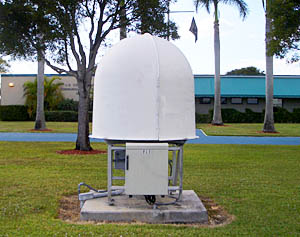Ground Stations
Local User Terminals (LUTs)
 Cospas-Sarsat ground stations are called Local User Terminals (LUTs). These satellite receiving units are the ground stations that receive emergency beacon distress alerts. There are two-types of LUTs. The Low Earth Orbiting LUTs (LEOLUTs) and the Geostationary LUTs (GEOLUTs).
Cospas-Sarsat ground stations are called Local User Terminals (LUTs). These satellite receiving units are the ground stations that receive emergency beacon distress alerts. There are two-types of LUTs. The Low Earth Orbiting LUTs (LEOLUTs) and the Geostationary LUTs (GEOLUTs).
LEOLUTs are designed to track the Cospas-Sarsat satellites as they pass across the sky and receive the distress signals relayed by them. The LEOLUT usually consists of a tracking-enabled antenna, a processor, and communications equipment.
A GEOLUT is fixed on one of the Cospas-Sarsat Geostationary satellites and receives the distress signals detected by the Geostationary satellite. This process occurs within a matter of seconds of beacon activation.
Once a signal is received and processed at the LUT it is transmitted to the mission control center (MCC) that operates that particular LUT. The LUTs are fully automated and completely unmanned at all times. In the U.S., NOAA operates twelve LEOLUTs in six locations and operates two GEOLUTs with a third for use in various testing and engineering activities. These multiple LUTs provide total system redundancy and allows for a maximization of satellite tracking. There are two LEOLUTs in each of the following locations:
- Suitland, Maryland (NOAA Satellite Operations Facility)
- Miami, Florida (USCG Communications Station)
- Vandenberg AFB, California
- Fairbanks, Alaska (NOAA Satellite CDA Station)
- Wahiawa, Hawaii (USCG Communications Station)
- Andersen AFB, Guam
There are currently 57 LEOLUTs in operation worldwide with several more being built each year. Click here to see a map of the LEOLUT locations.
The GEOLUTs are located in Suitland, Maryland at the U.S. Mission Control Center housed in NOAA’s Satellite Operations Facility on the Suitland Federal Center. There are currently 20 GEOLUTs in operation around the world. Click here to see locations of the GEOLUTs.
